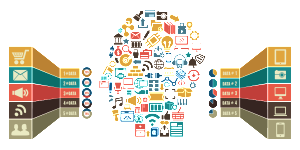
Should every visitor to your website be treated the same? Should each customer see the exact same offers, options, products and pages?
The more forward-thinking online marketers recognize that “personalizing” each customer’s experience on their site can make a dramatic difference in ultimate sales, customer loyalty and long-term profitability of the business.
Fact is, in many markets, customers have actually come to expect individually tailored offers and experiences—based on who they are, what they’ve bought before or even how they have come to the site.
But exactly what should you personalize on the site? Which offers, products or promotions should you present to which customer? And how can you tell what each type of customer will respond to best?
When you know what you want to accomplish, you will be able to identify the right combination of technology, tools and strategy for personalizing each customer’s experience. Here is where to start:
Harness the Power of Big Data, Big Testing
The notion of big data holds great promise for finding ways to personalizing the Web experience for individual customers. The vast amounts of data on customer behavior and history that can be captured via the Web and be invaluable in making decisions about how the website should work, what customers respond to, and understanding the discrete segments in your customer base.
Marketers who can harness the power of big data will be able to make decisions based on evidence, rather than guesswork—giving them a distinct advantage over the competition.
Of course, making sense of huge volumes of data, which may be in different forms and come from different sources, is not so easy. What’s more, it’s also difficult to translate that information into “personalizations” that are meaningful and compelling to your customers.
That is where today’s more advanced tools come in.
The aggregation and use of big data are crucial to segmenting and targeting your individual customers with the appropriate experiences. It requires employing predictive behavioral targeting and optimization techniques to remove the complexity. Your systems need to make real-time digital decisions for the masses—anytime, anywhere.
Love Your Loyalty Programs
For most marketers, loyalty programs provide a wealth of personalized data on your most desirable customers. But once you’ve enrolled customers, what should you do with the data?
This data isn’t just for tracking points and past reservations. It can be used to digitally personalize the experience for each customer in real time. Initiatives like offers, promotions, calls to action, special prices—whether on your website, mobile site or app—can all be preselected or promoted based on each visitor’s unique profile. This tactic ensures visitors see content relevant only to their loyalty level and behavior. A better experience leads to higher loyalty.
With each loyalty program visitor who comes to your website comes their unique “virtual profile” that can—and should—be used to tailor their experience on your site, in real time. Insight on behaviors such as previous products researched, frequency of purchases, the nature of past purchases, and ads or offers they’ve clicked can inform what content and offers you should make available to each individual, and precisely when in the process.
Don’t Upsell or Cross-Sell Too Soon

One mistake marketers often make is automatically tagging on extras, such as upsells, options or accessory products, as their customers enter the booking funnel. The customer who already had a price in mind suddenly sees that number increase just as it’s time to purchase. By forcing these add-ons at the wrong time, you’re more likely to elevate annoyance levels than average sales.
With recommendations, upselling and cross-selling, timing is everything. Don’t be pushy up front; instead, leverage CRM and personalization data to get the right offer in the customer’s face at the right moment.
Ditch the Rules; Get Automated
While rules-based targeting may work, it won’t get you very far when you’re trying to personalize offers for millions of site visitors. It is virtually impossible to manually create rules that can handle the thousands of combinations of behaviors, products and promotions, for every single person.
The next best option (and next big idea) is automated personalization solutions. Advanced predictive models can dynamically serve content and offers based on a user’s current and past online behavior. This way, your visitors will always have the most relevant and appropriate experience on home pages, landing pages, search engine results pages, the booking funnel and every page in between. In the case of repeat visitors to your site, for example, you might retarget them with an offer based on their last purchase, or their last search, all in real time.
Making sure these tools are on hand can ultimately help the business build consumer-centric promotional strategies.
Sync Your Channels
Your customers don’t think in channels; they think in brands. So they expect the same personalized experience they get on your site to be on their smartphones, in their email and even on Facebook. Customer experience is the number one ticket to prolonged brand loyalty and engagement.
How does your brand look across channels? Is it 100 percent consistent, optimized and personalized? If not, you could be missing a golden opportunity to improve hotel, call center, direct mail, social and mobile experiences. No matter where they visit you, your brand experience should be ready. Thanks to automated technologies, you can more accurately predict a customer’s next interest and follow up with optimized, targeted messaging, no matter how, or through which channel, they access your brand.
Combining this data with CRM data in real time to drive sales and customer retention is the future. CRM practices were born and bred in the offline world, but today marrying offline, online and mobile consumer data through new technologies can help you achieve better CRM and multichannel marketing outcomes: more precise targeting, personalization and consumer connections across all media channels, and delivered at the time most appropriate to increasing conversion—a very important factor in online marketing.
Imagine being able to target your consumers across the various phases of purchase with different messages at research, selection, shipping and the like. Not only can you dramatically enhance and personalize their experience with your brand, but increased retention, loyalty and customer lifetime values also result from a truly connected multichannel experience.
Remember, personalization isn’t just marketing hype. It’s a complex concept that really can live up to its billing. But first, marketers must identify what personalization really means in their business—and what it means to their objectives, target customers and buying cycles.
When it comes to their websites, mobile sites, apps, social media and CRM platforms, the online industry must realize that only through a customized combination of multivariate testing, optimization and personalization best practices can they truly begin to reach consumers with personalization that is effective and full of impact. There are no easy answers or instant solutions for creating personalization that works. It’s about evolution rather than revolution.













